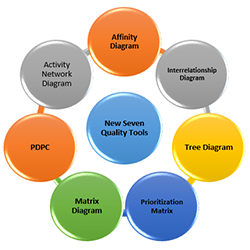7 QC Tools

The Seven Basic Tools of Quality (also known as 7 QC Tools) originated in Japan when the country was undergoing major quality revolution and had become a mandatory topic as part of Japanese’s industrial training program. These tools which comprised of simple graphical and statistical techniques were helpful in solving critical quality related issues. These tools were often referred as Seven Basics Tools of Quality because these tools could be implemented by any person with very basic training in statistics and were simple to apply to solve quality-related complex issues.
The seven tools are:
- Cause-and-effect diagram (also known as the “fishbone” or Ishikawa diagram)
- Check sheet
- Control chart
- Histogram
- Pareto chart
- Scatter diagram
- Stratification (alternately, flow chart or run chart)
Need help developing your 7 QC Tools?

